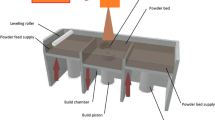Abstract
In order to reveal the distortion mechanism of PLA thin-plate part in the FDM process, a theoretical model based on the theory of elastic thin plates in thermoelasticity was established, and an experimental research approach based on Taguchi method was presented. A special specimen was designed, and the flowchart of experimental procedure was elaborated. Moreover, 81 test specimens were prepared through FDM process and measured by a portable 3D laser scanner. Two statistical analysis methods, signal to noise ratio (S/N) and analysis of variance (ANOVA), were applied to optimize the process parameters in order to reduce the distortion of thin-plate part. The experimental results indicated that the optimal process parameters can be obtained and proposed theoretical model was proved efficient.
Similar content being viewed by others
References
Chua CK, Leong KF, Lim CS (2010) Rapid prototyping: principles and applications. World Scientific
Yan X, Gu P (1996) A review of rapid prototyping technologies and systems. Comput-Aided Des 28(4):307–318
Petzold R, Zeilhofer HF, Kalender WA (1999) Rapid prototyping technology in medicine-basics and applications. Comput Med Imaging Graph 23(5):277–284
Boschetto A, Giordano V, Veniali F (2012) Modelling micro geometrical profiles in fused deposition process. Int J Adv Manuf Technol 61(9–12):945–956
Zein I, Hutmacher DW, Tan KC, Teoh SW (2002) Fused deposition modeling of novel scaffold architectures for tissue engineering application. Biomaterials 23(4):1169–1185
Peng A, Xiao XM, Yue R (2014) Process parameter optimization for fused deposition modeling using response surface methodology combined with fuzzy inference system. Int J Adv Manuf Technol 73(1–4):87–100
Rutkowski JV, Levin BC (1986) Acrylonitrile-butadiene-styrene copolymers (ABS): Pyrolysis and combustion products and their toxicity-a review of the literature. Fire Mater 10(3–4):93–105
Drumright RE, Gruber PR, Henton DE (2000) Polylactic acid technology. Adv Mater 12(23):1841–1846
Madhavan NK, Nair NR, John RP (2010) An overview of the recent developments in polylactide (PLA) research. Bioresour Technol 101(22):8493–8501
Tymrak BM, Kreiger M, Pearce JM (2014) Mechanical properties of components fabricated with open-source 3-D printers under realistic environmental conditions. Mater Des 58:242–246
Kantaros A, Karalekas D (2013) Fiber Bragg grating based investigation of residual strains in ABS parts fabricated by fused deposition modeling process. Mater Des 50:44–50
Wang TM, Xi JT, Jin Y (2007) A model research for part warp deformation in the FDM process. Int J Adv Manuf Technol 33(11–12):1087–1096
Vatani M, Barazandeh F, Rahimi AR, Nezhad AS (2012) Distortion modeling of SL parts by classical lamination theory. Rapid Prototyp J 18(3):188–193
Kim GD, Lee JK (2005) Prediction of curl distortion using classical lamination theory in stereolithography. J Korean Soc Precis Eng 22(11):210–217
Yan XR, Yan YN, Zhang RJ, Guo YH (2003) Study on the Interlaminar Stress and Warping Deformation in Laminated Object Manufacturing. Chin J Mech Eng 39(5):36–40
Xu HY, Zhang Y, LuB CDY (2004) Numerical simulation of solidified deformation of resin parts in stereolithography rapid protyping. Chin J Mech Eng 40(6):107–112
Jayanthi S, Keefe M, Gargiulo EP (1994) Studies in stereolithography: influence of process parameters on curl distortion in photopolymer models. In: Solid Freeform Fabrication Symposium 1994. University of Texas, Austin, 250-258
Wiedemann B, Dusel KH, Eschl J (1995) Investigation into the influence of material and process on part distortion. Rapid Prototyp J 1(3):17–22
Dalgarno KW, Childs THC, Rowntree I, Rothwell L (1996) Finite element analysis of curl development in the selective laser sintering process. In: Proceedings of the Solid Freeform Fabrication Symposium, 559-566
Sonmez FO, Hahn HT (1998) Thermomechanical analysis of the laminated object manufacturing (LOM) process. Rapid Prototyp J 4(1):26–36
Nickel AH, Barnett DM, Prinz FB (2001) Thermal stresses and deposition patterns in layered manufacturing. Mater Sci Eng A 317(1):59–64
Zhang Y, Chou K (2008) A parametric study of part distortions in fused deposition modelling using three-dimensional finite element analysis. Proceedings of the Institution of Mechanical Engineers, Part B. J Eng Manuf 222(8):959–968
Yugang D, Suqin W, Hao C, Lu BH (2000) Study on the Effect of Photocuring Resin Shrinkage on Parts Curl Distortion in the Process of Laser Rapid Prototyping. Chem Eng (China) 6:013
Wanhua Z, Dichen L, Bingheng L (2001) Investigation of the Part Deformation in Stereolithography. J Xi An Jiao Tong Univ 35(7):705–708
Yang HJ, Hwang PJ, Lee SH (2002) A study on shrinkage compensation of the SLS process by using the Taguchi method. Int J Mach Tool Manuf 42(11):1203–1212
Mahesh M, Wong YS, Fuh JYH, Loh HT (2004) Benchmarking for comparative evaluation of RP systems and processes. Rapid Prototyp J 10(2):123–135
Buchbinder D, Meiners W, Pirch N, Wissenbach K (2014) Investigation on reducing distortion by preheating during manufacture of aluminum components using selective laser melting. J Laser Appl 26(1):012004
Youssef HM (2011) Theory of two-temperature thermoelasticity without energy dissipation. J Therm Stresses 34(2):138–146
Boley BA, Weiner JH (2012) Theory of thermal stresses. Courier Dover Publications
Long S, Atluri SN (2002) A meshless local Petrov-Galerkin method for solving the bending problem of a thin plate. Comput Model Eng Sci 3(1):53–64
Sood AK, Equbal A, Toppo V, Ohdarb RK, Mahapatra SS (2012) An investigation on sliding wear of FDM built parts. CIRP J Manuf Sci Technol 5(1):48–54
Rayegani F, Onwubolu GC (2014) Fused deposition modelling (FDM) process parameter prediction and optimization using group method for data handling (GMDH) and differential evolution (DE). Int J Adv Manuf Technol 73(1–4):509–519
Roy RK (2010) A primer on the Taguchi method. Society of Manufacturing Engineers
Author information
Authors and Affiliations
Corresponding author
Rights and permissions
About this article
Cite this article
Xinhua, L., Shengpeng, L., Zhou, L. et al. An investigation on distortion of PLA thin-plate part in the FDM process. Int J Adv Manuf Technol 79, 1117–1126 (2015). https://doi.org/10.1007/s00170-015-6893-9
Received:
Accepted:
Published:
Issue Date:
DOI: https://doi.org/10.1007/s00170-015-6893-9




